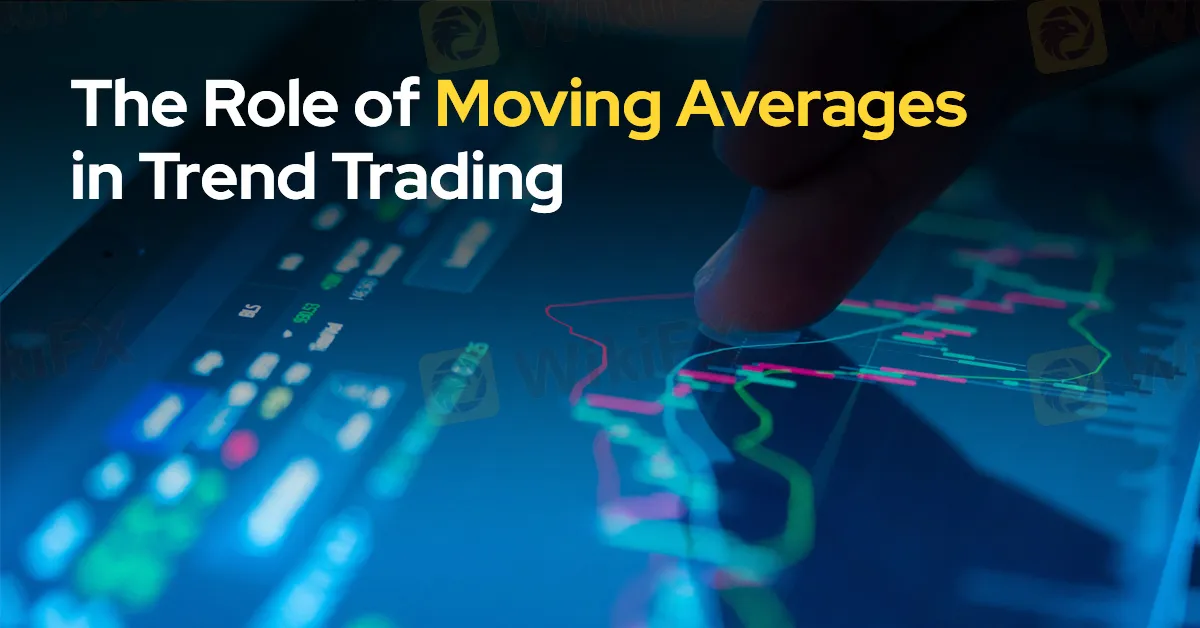简体中文
繁體中文
English
Pусский
日本語
ภาษาไทย
Tiếng Việt
Bahasa Indonesia
Español
हिन्दी
Filippiiniläinen
Français
Deutsch
Português
Türkçe
한국어
العربية
The Role of Moving Averages in Trend Trading
Abstract:Moving averages are essential tools in technical analysis, widely used by traders to identify trends and make informed decisions. By smoothing out price data, moving averages help traders filter out noise and determine the overall direction of a market, making them invaluable in trend trading strategies.

Introduction
Moving averages are essential tools in technical analysis, widely used by traders to identify trends and make informed decisions. By smoothing out price data, moving averages help traders filter out noise and determine the overall direction of a market, making them invaluable in trend trading strategies.
What are Moving Averages?
A moving average (MA) is a statistical calculation that averages a set of data points over a specific period. In trading, the most common types are:
Simple Moving Average (SMA): This is calculated by summing the closing prices over a designated number of periods and dividing by that number. It provides a straightforward average but can lag behind current prices.
Exponential Moving Average (EMA): This gives more weight to recent prices, making it more responsive to new information. EMAs are favored by many traders for their sensitivity to price changes.
Identifying Trends with Moving Averages
Moving averages are primarily used to identify market trends. Heres how they can aid trend trading:
Trend Direction: When prices are above the moving average, it generally indicates an uptrend, while prices below suggest a downtrend. This visual representation helps traders align their positions with the prevailing trend.
Crossovers: One of the most popular strategies involves using two moving averages—a shorter period and a longer period. A bullish crossover occurs when the shorter MA crosses above the longer MA, signaling a potential buy opportunity. Conversely, a bearish crossover happens when the shorter MA crosses below the longer MA, indicating a potential sell signal.
Support and Resistance Levels: Moving averages can act as dynamic support and resistance levels. In an uptrend, the moving average may serve as support, while in a downtrend, it can act as resistance. Traders often look for price action around these averages to make decisions.
Combining Moving Averages with Other Indicators
While moving averages are powerful on their own, they are often more effective when combined with other technical indicators. For example:
Relative Strength Index (RSI): This momentum oscillator can help confirm trends identified by moving averages. A bullish signal is stronger when the RSI is above 50, while a bearish signal is confirmed when its below 50.
MACD (Moving Average Convergence Divergence): This indicator uses moving averages to identify momentum and trend changes. Traders can look for crossovers and divergence between MACD and price action for additional confirmation.
Limitations of Moving Averages
Despite their usefulness, moving averages have some limitations:
Lagging Indicator: Moving averages are lagging indicators, meaning they react to price changes rather than predict them. This delay can result in late entry or exit points.
Whipsaws in Sideways Markets: In choppy or sideways markets, moving averages can produce false signals, leading to potential losses.
Parameter Sensitivity: The effectiveness of moving averages depends on the chosen time period. Shorter periods can generate more signals but may also increase noise, while longer periods smooth out fluctuations but can delay signals.
Conclusion
Moving averages play a crucial role in trend trading, helping traders identify and capitalize on market trends. By providing insights into trend direction, potential entry and exit points, and acting as dynamic support and resistance, moving averages can enhance trading strategies. However, traders should be mindful of their limitations and consider combining them with other indicators to improve overall effectiveness. Understanding how to leverage moving averages can significantly enhance a trader's ability to navigate the ever-changing forex market.

Disclaimer:
The views in this article only represent the author's personal views, and do not constitute investment advice on this platform. This platform does not guarantee the accuracy, completeness and timeliness of the information in the article, and will not be liable for any loss caused by the use of or reliance on the information in the article.
Read more

BlackBull: A Closer Look at Its Licenses
When selecting a broker, understanding its regulatory standing is an important part of assessing overall reliability. For traders seeking to protect their capital, ensuring that a platform operates under recognised and stringent oversight can make all the difference. Keep reading to learn more about BlackBull and its licenses.

Dark Side of AETOS: They Don’t Want You to Know
AETOS is an Australia-based broker. All over the internet, you will find positive reviews about this broker, but no one is talking about the risks involved with AETOS. However, we have exposed the hidden risks associated with AETOS

Contemplating Investments in Quotex? Abandon Your Plan Before You Lose All Your Funds
Have you received calls from Quotex executives claiming to offer you returns of over 50% per month? Do you face both deposit and withdrawal issues at this company? Or have you faced a complete scam trading with this forex broker? You're not alone. Here is the exposure story.

15 Brokers FCA Says "Are Operating Illegally" Beware!
If a reputable regulator issues a warning about unlicensed brokers, it's important to take it seriously — whether you're a trader or an investor. Here is a list you can check out- be cautious and avoid getting involved with these scam brokers.
WikiFX Broker
Latest News
Scam Alert: Revealing Top Four Forex Scam Tactics Employed to Dupe Investors
Meta says it won't sign Europe AI agreement, calling it an overreach that will stunt growth
Ether and trading stocks take the crypto spotlight as Congress passes historic stablecoin bill
Inflation outlook tumbles to pre-tariff levels in latest University of Michigan survey
Peter Thiel-backed cryptocurrency exchange Bullish files to go public on NYSE
What a Trump, Powell faceoff means for your money
Ether takes crypto spotlight as Congress passes historic stablecoin bill
Lead Prices Remain in the Doldrums Despite Seasonal Expectations
Myanmar Tin Ore Shipments from Wa Region Set to Resume
Major U.S. Banks Plan Stablecoin Launch Amid Crypto Regulations
Currency Calculator


